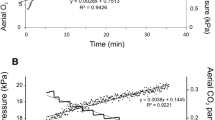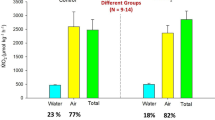Abstract
We examined the energy status, nitrogen metabolism and hepatic glutamate dehydrogenase activity in the African lungfish Protopterus annectens during aestivation in normoxia (air) or hypoxia (2% O2 in N2), with tissues sampled on day 3 (aerial exposure with preparation for aestivation), day 6 (entering into aestivation) or day 12 (undergoing aestivation). There was no accumulation of ammonia in tissues of fish exposed to normoxia or hypoxia throughout the 12-day period. Ammonia toxicity was avoided by increased urea synthesis and/or decreased endogenous N production (as ammonia), but the dependency on these two mechanisms differed between the normoxic and the hypoxic fish. The rate of urea synthesis increased 2.4-fold, with only a 12% decrease in the rate of N production in the normoxic fish. By contrast, the rate of N production in the hypoxic fish decreased by 58%, with no increase in the rate of urea synthesis. Using in vivo 31P NMR spectroscopy, it was demonstrated that hypoxia led to significantly lower ATP concentration on day 12 and significantly lower creatine phosphate concentration on days 1, 6, 9 and 12 in the anterior region of the fish as compared with normoxia. Additionally, the hypoxic fish had lower creatine phosphate concentration in the middle region than the normoxic fish on day 9. Hence, lowering the dependency on increased urea synthesis to detoxify ammonia, which is energy intensive by reducing N production, would conserve cellular energy during aestivation in hypoxia. Indeed, there were significant increases in glutamate concentrations in tissues of fish aestivating in hypoxia, which indicates decreases in its degradation and/or transamination. Furthermore, there were significant increases in the hepatic glutamate dehydrogenase (GDH) amination activity, the amination/deamination ratio and the dependency of the amination activity on ADP activation in fish on days 6 and 12 in hypoxia, but similar changes occurred only in the normoxic fish on day 12. Therefore, our results indicate for the first time that P. annectens exhibited different adaptive responses during aestivation in normoxia and in hypoxia. They also indicate that reduction in nitrogen metabolism, and probably metabolic rate, did not occur simply in association with aestivation (in normoxia) but responded more effectively to a combined effect of aestivation and hypoxia.




Similar content being viewed by others
Abbreviations
- ADP:
-
Adenosine diphosphate
- ATP:
-
Adenosine triphosphate
- EDTA:
-
Ethylenediaminetetraacetic acid
- EGTA:
-
Ethylene glycol-tetraacetic acid
- FAA:
-
Free amino acid
- GDH:
-
Glutamate dehydrogenase
- α-KG:
-
α-Ketoglutarate
- N:
-
Nitrogen
- NADH:
-
β-Nicotinamide adenine dinucleotide, reduced
- NAD:
-
β-Nicotinamide adenine dinucleotide
- NaF:
-
Sodium fluoride
- 31P NMR:
-
31Phosphorus nuclear magnetic resonance
- PMSF:
-
Phenylmethyl sulfonyl fluoride
- TFAA:
-
Total free amino acid
- TEFAA:
-
Total essential free amino acid
References
Bergmeyer HU, Beutler HO (1985) Ammonia. In: Bergmeyer HU, Bergmeyer J, Grabl M (ed) Methods of enzymatic analysis, vol VIII. Verlag Chemie, Weinheim, pp 454–461
Brusilow SW (2002) Reviews in molecular medicine—hyperammonemic encephalopathy. Medicine 81:240–249
Campbell JW (1973) Nitrogen excretion. In: Prosser CL (ed) Comparative animal physiology, 3rd edn. Saunders College Publishing, Philadelphia, pp 279–316
Chew SF, Ong TF, Ho L, Tam WL, Loong AM, Hiong KC, Wong WP, Ip YK (2003) Urea synthesis in the African lungfish Protopterus dolloi—hepatic carbamoyl phosphate synthetase III and glutamine synthetase are upregulated by 6 days of aerial exposure. J Exp Biol 206:3615–3624
Chew SF, Chan NKY, Loong AM, Hiong KC, Tam WL, Ip YK (2004) Nitrogen metabolism in the African lungfish (Protopterus dolloi) aestivating in a mucus cocoon on land. J Exp Biol 207:777–786
Chew SF, Wilson JM, Ip YK, Randall DJ (2006) Nitrogen excretion and defense against ammonia toxicity. In: Val A, Almedia-Val, Randall DJ (ed) Fish physiology, vol 21, the physiology of tropical fishes. Academic Press, London, pp 307–396
Cooper JL, Plum F (1987) Biochemistry and physiology of brain ammonia. Physiol Rev 67:440–519
Felipo V, Butterworth RF (2002) Neurobiology of ammonia. Prog Neurobiol 67:259–279
Fishman AP, Pack AI, Delaney RG, Gallante RJ (1987) Estivation in Protopterus. In: Bemis WE, Burggren WW, Kemp NE (eds) The biology and evolution of lungfishes. Alan R. Liss Inc, New York, pp 163–179
Graham JB (1997) Diversity and natural history. In: Air-breathing fishes: evolution, diversity and adaptation. Academic Press, San Diego, pp 223–240
Hermenegildo C, Marcaida G, Montoliu C, Grisolia S, Minana M, Felipo V (1996) NMDA receptor antagonists prevent acute ammonia toxicity in mice. Neurochem Res 21:1237–1244
Herrero-Yraola A, Bakhit SMA, Franke P, Weise C, Schweiger M, Jorcke D, Ziegler M (2001) Regulation of glutamate dehydrogenase by reversible ADP-riboysylation in mitochondria. EMBO J 20:2404–2412
Hochachka PW (1980) Living without oxygen. Harvard University Press, Cambridge
Ip YK, Chew SF, Peng KW, Lim RLW (1992) Effects of environmental anoxia on the amino acid compositions and kinetic properties of glutamate dehydrogenase in three body parts of Phascolosoma arcuatum. J Exp Mar Biol Ecol 165:125–132
Ip YK, Chew SF, Randall DJ (2001) Ammonia toxicity, tolerance and excretion. In: Wright PA, Anderson PM (ed) Fish physiology, vol 20. Academic Press, San Diego, pp 109–148
Ip YK, Chew SF, Randall DJ (2004) Five tropical air-breathing fishes, six different strategies to defend against ammonia toxicity during aerial exposure. Physiol Biochem Zool 77:768–782
Ip YK, Peh BK, Tam WL, Lee SLM, Chew SF (2005a) Changes in salinity and ionic compositions act as environmental signals to induce a reduction in ammonia production in the African lungfish Protopterus dolloi. J Exp Zool 303A:456–463
Ip YK, Peng KW, Chew SF, Lim RLW, Tan GQ (1994) Ammonia production and kinetic properties of glutamate dehydrogenase in the sipunculid Phascolosoma arcuatum exposed to anoxia. Mar Biol 119:261–266
Ip YK, Yeo PJ, Loong AM, Hiong KC, Wong WP, Chew SF (2005b) The interplay of increased urea synthesis and reduced ammonia production in the African lungfish Protopterus aethiopicus during 46 days of aestivation in a mucus cocoon on land. J Exp Zool 303A:1054–1065
Janssens PA (1964) The metabolism of the aestivating African lungfish. Comp Biochem Physiol 11:105–117
Janssens PA, Cohen PP (1966) Ornithine-urea cycle enzymes in the African lungfish Protopterus aethiopicus. Science 152:358–359
Janssens PA, Cohen PP (1968a) Biosynthesis of urea in the estivating African lungfish and in Xenopus laevis under conditions of water shortage. Comp Biochem Physiol 24:887–898
Janssens PA, Cohen PP (1968b) Nitrogen metabolism in the African lungfish. Comp Biochem Physiol 24:879–886
Jow LY, Chew SF, Lim CB, Anderson PM, Ip YK (1999) The marble goby Oxyeleotris marmoratus activates hepatic glutamine synthetase and detoxifies ammonia to glutamine during air exposure. J Exp Biol 202:237–245
Kemp GJ, Meyerspeer M, Moser E (2007) Absolute quantification of phosphorus metabolite concentrations in human muscle in vivo by 31P MRS: a quantitative review. NMR Biomed 20:555–565
Loong AM, Hiong KC, Lee SLM, Wong WP, Chew SF, Ip YK (2005) Ornithine-urea cycle and urea synthesis in African lungfishes, Protopterus aethiopicus and Protopterus annectens, exposed to terrestrial conditions for 6 days. J Exp Zool 303A:354–365
Loong AM, Pang CYM, Hiong KC, Wong WP, Chew SF, Ip YK (2008) Increased urea synthesis and/or suppressed ammonia production in the African lungfish, Protopterus annectens: aestivation in air versus aestivation in mud. J Comp Physiol B 178:351–363
Melzner F, Bock C, Pörtner HO (2006) Critical temperatures in the cephalopod Sepia officinalis investigated using in vivo 31P NMR spectroscopy. J Exp Biol 209:891–906
Mommsen TP, Walsh PJ (1989) Evolution of urea synthesis in vertebrates: the piscine connection. Science 243:72–75
Peng KW, Chew SF, Ip YK (1994) Free amino-acids and cell volume regulation in the Sipunculid Phascolosoma arcuatum. Physiol Zool 67:580–597
Perry SF, Gilmour KM, Vulesevic B, McNeil B, Chew SF, Ip YK (2005) Circulating catecholamines and cardiorespiratory responses in hypoxic lungfish (Protopterus dolloi): A comparison of aquatic and aerial hypoxia. Physiol Biochem Zool 78:325–334
Perry SF, Euverman R, Wang T, Loong AM, Chew SF, Ip YK, Gilmour KM (2008) Control of breathing in African lungfish (Protopterus dolloi): A comparison of aquatic and cocooned (terrestrialized) animals. Resp Physiol Neurobiol 160:8–17
Person Le Ruyet J, Boeuf G, Zambonino Infante J, Helgason S, Le Roux A (1998) Short-term physiological changes in turbot and seabream juveniles exposed to exogenous ammonia. Comp Biochem Physiol 119A:511–518
Plaitakis A, Zaganas J (2001) Regulation of human glutamate dehydrogenase: implications for glutamate, ammonia and energy metabolism in brain. J Neurosci Res 66:899–908
Plaxton WC, Storey KB (1985) Tissue specific isozyme of pyruvate kinase in the channelled whelk, Busycotypus cannaliculatum: enzyme modification in response to environmental anoxia. J Comp Physiol 155B:291–296
Prosser CL (1973) Muscles. In: Prosser CL (ed) Comparative animal physiology, 3rd edn. Saunders College Publishing, Philadelphia, pp 279–316
Rose C (2002) Increased extracellular brain glutamate in acute liver failure: decreased uptake or increased release? Metab Brain Dis 17:251–261
Smith HW (1930) Metabolism of the Lungfish, Protopterus aethiopicus. J Biol Chem 88:97–130
Smith HW (1935) The metabolism of the lungfish II. Effect of feeding meat on metabolic rate. J Cell Comp Physiol 6:335–349
Storey KB (2002) Life in the slow land: molecular mechanisms of estivation. Comp Biochem Physiol A 133:733–754
Thatcher BJ, Storey KN (2001) Glutamate dehydrogenase from liver of euthermic and hibernating Richardson’s ground squirrels: evidence for two distinct enzyme forms. Biochem Cell Biol 79:11–19
Wood CM, Walsh PJ, Chew SF, Ip YK (2005) Greatly elevated urea excretion after air exposure appears to be carrier mediated in the slender lungfish (Protopterus dolloi). Physiol Biochem Zool 78:893–907
Author information
Authors and Affiliations
Corresponding author
Additional information
Communicated by I.D. Hume.
Rights and permissions
About this article
Cite this article
Loong, A.M., Ang, S.F., Wong, W.P. et al. Effects of hypoxia on the energy status and nitrogen metabolism of African lungfish during aestivation in a mucus cocoon. J Comp Physiol B 178, 853–865 (2008). https://doi.org/10.1007/s00360-008-0273-9
Received:
Revised:
Accepted:
Published:
Issue Date:
DOI: https://doi.org/10.1007/s00360-008-0273-9




